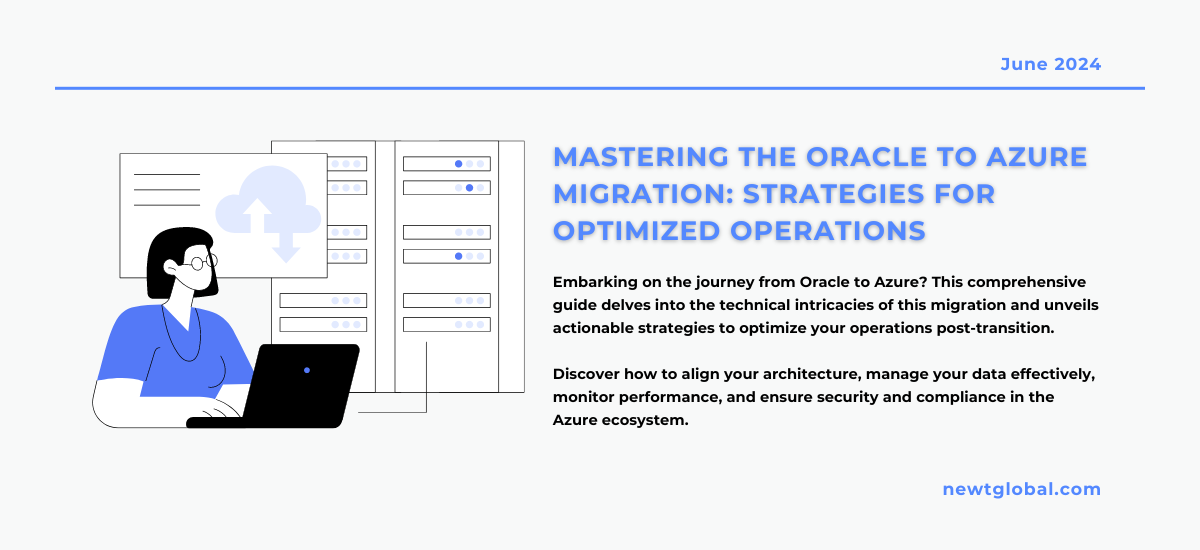
Are you part of an organization considering migrating from Oracle to Azure? Are you a database migration professional seeking strategies for optimizing operations post-migration? This blog is tailored for you. Dive into the technical nuances of transitioning from Oracle to Azure and discover key strategies for operational optimization in the post-migration landscape.
You’re eager to gain a deeper understanding of the technical aspects of migrating from Oracle to Azure and to learn actionable strategies for optimizing operations post-migration. You’re seeking practical guidance and technical expertise to navigate the complexities of this transition and to ensure a smooth migration experience.
Let’s dive into the technical details of migrating from Oracle to Azure and explore actionable strategies for optimizing operations in the Azure environment post-migration.
Understanding the Transition
Migrating from Oracle to Azure involves more than just transferring data and applications; it requires a comprehensive understanding of the technical differences between the two platforms and the implications of the migration on various operational aspects. As an Oracle user, you’re accustomed to its architecture and functionalities. However, transitioning to Azure requires familiarizing yourself with Azure’s cloud-native approach and understanding how it differs from Oracle’s architecture. For database migration professionals, it’s essential to assess the technical complexities of database migration, including schema conversion, data migration, and application compatibility. Understanding these nuances is critical for devising a comprehensive migration strategy and ensuring a seamless transition to the Azure environment.
Operational Optimization Strategies
Technical Alignment
-
-
- Evaluate the architecture and design of applications to identify any components or functionalities that may need to be redesigned or rearchitected to align with Azure’s cloud-native approach.
- Utilize Azure’s compatibility assessment tools to identify any potential compatibility issues with existing applications and databases, and develop a plan to address them proactively.
- Optimize database configurations, indexing strategies, and query performance to ensure optimal performance and scalability in the Azure environment.
-
Data Management
-
-
- Develop a comprehensive data migration plan that outlines the migration strategy, data mapping, transformation rules, and validation procedures to ensure a seamless transition of data from Oracle to Azure.
- Leverage Azure’s data migration services and tools to automate and streamline the data migration process, minimizing downtime and disruptions to business operations.
- Implement data governance policies and data lifecycle management practices to ensure data integrity, security, and compliance in the Azure environment.
-
Performance Monitoring and Tuning
-
-
- Utilize Azure Monitor and Azure Advisor to monitor system performance, identify performance bottlenecks, and optimize resource utilization.
- Implement automated scaling policies and load balancing strategies to dynamically adjust resources based on workload demands and optimize performance and cost-effectiveness.
- Continuously monitor and analyze application and database performance metrics to identify optimization opportunities and fine-tune configurations for optimal performance.
-
Automation and Orchestration
-
-
- Leverage Azure Automation and Azure Resource Manager templates to automate routine operational tasks such as provisioning, configuration management, and patching.
- Implement infrastructure as code (IaC) principles to define and manage infrastructure configurations and deployments programmatically, ensuring consistency, reliability, and repeatability.
- Utilize Azure DevOps pipelines and CI/CD (Continuous Integration/Continuous Deployment) practices to automate application deployments and streamline the software development lifecycle.
-
Security and Compliance
-
-
- Implement Azure Security Center and Azure Policy to enforce security best practices, monitor security configurations, and detect and respond to security threats and vulnerabilities.
- Utilize Azure Key Vault to securely store and manage cryptographic keys, secrets, and certificates used to authenticate and authorize access to resources and data.
- Implement data encryption, access controls, and auditing mechanisms to protect sensitive data and ensure compliance with regulatory requirements such as GDPR, HIPAA, and PCI DSS.
-
Adapting to Change:
Organizational Alignment
-
-
- Foster alignment and collaboration across IT teams, business units, and stakeholders to ensure a cohesive approach to operational optimization and adaptation to the Azure environment.
- Establish clear roles, responsibilities, and communication channels to facilitate collaboration and decision-making throughout the migration process and beyond.
-
Continuous Improvement
-
-
- Foster a culture of continuous improvement and innovation by encouraging feedback, experimentation, and learning from both successes and failures.
- Establish mechanisms for gathering and analyzing feedback from end-users, stakeholders, and operational teams to identify areas for improvement and drive ongoing optimization efforts.
-
Training and Skill Development
-
-
- Invest in training and skill development programs to upskill IT staff and equip them with the necessary knowledge and expertise to operate effectively within the Azure environment.
- Provide opportunities for hands-on experience and certification training in Azure technologies to enable IT professionals to stay current with emerging trends and best practices.
-
Collaboration and Knowledge Sharing
-
-
- Establish communities of practice and knowledge-sharing forums to facilitate collaboration, knowledge exchange, and peer learning among IT professionals working on Azure-related projects.
- Encourage cross-functional collaboration and knowledge sharing between development, operations, security, and compliance teams to foster a holistic understanding of the operational requirements and implications of the Azure environment.
-
Conclusion:
Adapting for Success: Operational Excellence in the Azure Environment
Migrating from Oracle to Azure is a transformative journey that requires careful planning and technical expertise. By implementing the strategies outlined in this blog, you can optimize operations and unlock the full potential of Azure post-migration. Embrace change with agility and innovation, and drive operational excellence in the Azure environment.
Visit newtglobal.com to explore our comprehensive range of cloud services and solutions. From cloud migration and implementation to ongoing support and optimization, we offer end-to-end support to ensure your success in the cloud.
To discuss your specific needs and learn how we can assist you further, don’t hesitate to reach out to us at marketing@newtglobalcorp.com. Our team of experts is standing by to answer your questions, provide personalized guidance, and help you unlock the full potential of cloud technology for your organization.
